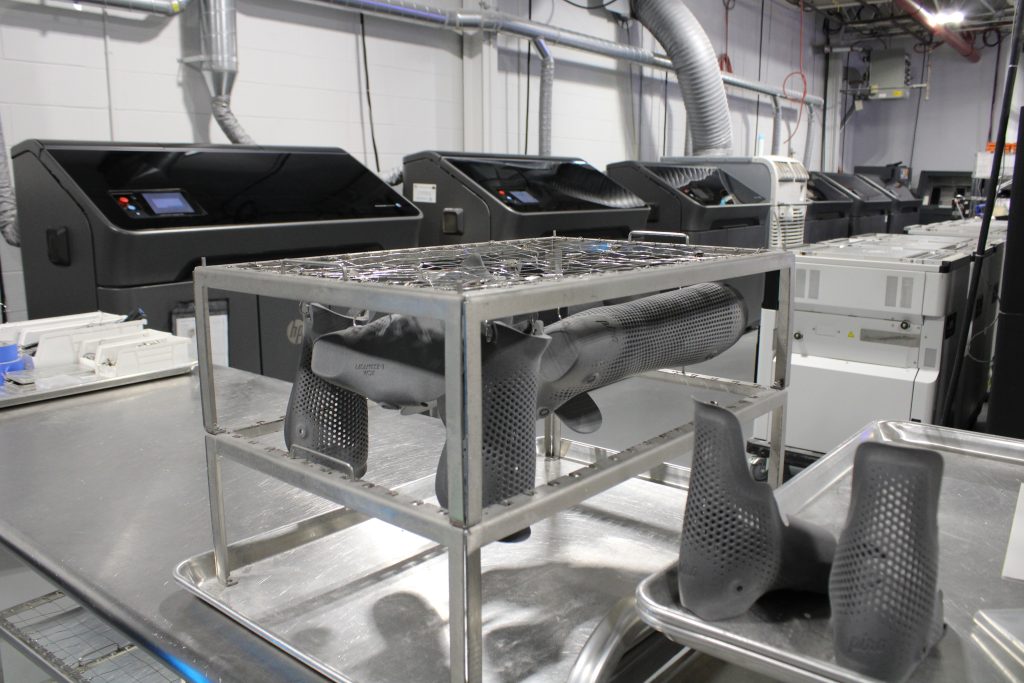I recently had the opportunity to hear how Additive Manufacturing or 3D Printing made a dramatic difference in someone’s life. Through a combination of digital scanning, CAD work, and 3D Printing, this client was able to get the “perfect fit” with his lower limb prosthetic — something he’s wanted for 20 years.
It reminded me of the sensitive side of manufacturing and how 3D Printing or Additive Manufacturing can be an asset to traditional manufacturing. As I mentioned in an earlier post, Additive Manufacturing continues to grow and touch on markets segments that are new and labor intensive that can benefit from the digital component of 3D Printing. As printing processes and materials develop, we will see more life changing benefits outside the traditional manufacturing space.

When we look at HP’s Multi Jet Fusion (MJF) process, we see a variety of materials for different applications. And the material that gave this client that “perfect fit” was BASF Ultrasint TPU01.
What is BASF Ultrasint TPU01?
Thermoplastic Polyurethane (TPU) is a very elastic and flexible material. It is durable, strong, and smooth to the touch, and it has high wear resistance, withstanding environments of oils, grease, and solvents. Additionally, TPU has superior resistance to high and low temperatures, making this material a great substitute for hard rubber parts.
Current markets that can benefit from the BASF TPU material are as follows:
- Sports
- Automotive
- Footwear
- Electronic cases
- Industrial tools/fixtures
- Orthotic & Prosthetic (O&P) and other medical applications
Each of these markets require unique material requirements and finishes. The Ultrasint TPU01 along with post processing applications can give the customer a part that is quicker to market with similar characteristics to a traditionally manufactured part.
Post Processing of TPU01
Several post-processing applications are available for the BASF TPU Ultrasint material. ABCorp 3D currently provides dyeing and vapor smoothing. When MJF printed, TPU01 will be grey in color; dyeing the part gives the printed part a black uniform color that has penetrated the part surface.
When Vapor Smoothing is added as a surface treatment, a part that has been printed with the MJF process will change from grey to black and parts that have been dyed will have a part finish with an average surface roughness (Ra) of around 1.18. This effectively seals the part, adding to the surface properties of moisture and airtightness along with improving bacteria protection.
Another popular post process is ceramic coatings: Cerakote and Durakote. Both have solutions for 3D Printed parts.
Latticing with Ultrasint TPU01
The lattice structure is found in nature and mimicked within the structural foam industry. Incorporating lattice design into the HP MJF printing process gives parts an additional level of performance properties. Parts can be printed with different lattice structures incorporated into specific areas of the part, and the result is added flexibility in those areas with what could be called a “customized durometer” applying to different areas of the part.
Latticing of MJF Printed TPU parts has opened up areas in the sports, O&P, and automotive industries.
A recent article in AM Magazine discussed how latticing along with TPU material can be used to better fit a sports helmet to the wearer’s head. The article goes on to note, “Meanwhile, padding made via 3D printing in this way can also be customized to the wearer by designing from a scan of the head. We experienced this with digital-material helmet padding that was made from our personal scan data.”
In the O&P field we are seeing parts that have custom lattice structures that specifically tailor to different parts of the prosthetic, giving a better fit and happier client. Just ask the guy that finally found the best prosthetic fit after 20 years!
“He was very excited about it. Happy to see we finally got him fit going totally plasterless — he has been working to that goal for the last 20 years”.
Who we are, what we do, and how to connect for more information.
ABCorp has been a secure contract manufacture since 1795, creating the first anti-counterfeit currency for the United States. As markets change, we now create and manufacture a good portion of the world’s plastic Credit Cards, Passports and Gift cards. When COVID hit, our punch presses transitioned to face masks and we ventured into Additive Manufacturing to help address the tightening supply chain concerns.
In a sort time ABCorp 3D Inc. has grown to house multiple HP MJF 580 and 5210 series printers in our secure Boston facility. Our current material offerings are Nylon PA-11, PA-12, Polypropylene and flexible TPU. The HP 580 creates colors parts in Nylon PA-12CB material.
If you’re in a position to review your parts for a digital inventory or would like us to print a few parts, please reach out to us. A CAD file with an .stl or 3MF file along with design specifications is enough to start the conversation.
And of course, samples are available upon request.
 Vic Little
Vic Little
Business Development
ABCorp-3D
